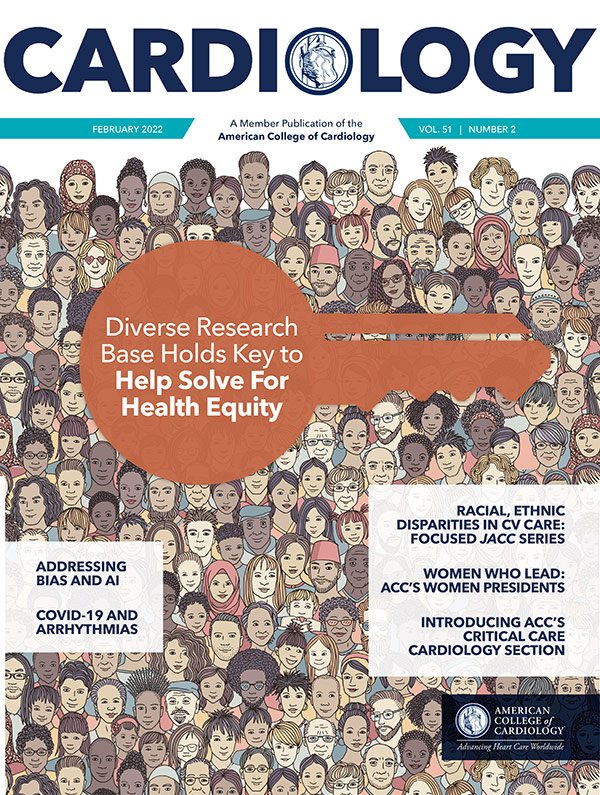Journal Wrap

The hottest research from various peer-reviewed journals – handpicked weekly by the ACC.org Editorial Board led by Kim A. Eagle, MD, MACC.
ADA Releases Updated Standards of Care For Patients With Diabetes
The American Diabetes Association (ADA) annual Standards of Medical Care in Diabetes includes new and updated guidance for managing patients with diabetes and prediabetes based on the latest scientific evidence and clinical trials. For the fourth consecutive year, the ACC endorsed the section focused on "Cardiovascular Disease and Risk Management."
The Standards of Care document, published in the January 2022 issue of Diabetes Care, provides the latest in comprehensive, evidence-based recommendations for the diagnosis and treatment of youth and adults with type 1, type 2, or gestational diabetes. It also includes strategies for the prevention or delay of type 2 diabetes and associated comorbidities and recommends therapeutic approaches that can reduce complications, mitigate cardiovascular and renal risk, and improve health outcomes.
Among the most notable updates and additions:
- Guidance on first-line therapy determined by comorbidities.
- Recommended screening for prediabetes and diabetes beginning at age 35 for all people.
- Changes to gestational diabetes mellitus (GDM) recommendations regarding when to test and in whom testing should be done.
- Updated recommendations on technology selection based on individual and caregiver considerations, ongoing education on use of devices, continued access to devices across payers, support of students using devices in school settings, use of telehealth visits, and early initiation of technology.
Other notable changes include more information on managing nonalcoholic fatty liver disease and nonalcoholic steatohepatitis in conjunction with diabetes, the role of health numeracy in diabetes prevention and management, cognitive impairment and diabetes, and COVID-19 updates based on evolving evidence.
American Diabetes Association Professional Practice Committee. Diabetes Care 2022;45(suppl 1):1-259.
NCDR Study: Sex-Based Outcomes After TEER Similar at One Year, But Lower Mortality in Women
Women undergoing percutaneous transcatheter edge-to-edge repair (TEER) of mitral regurgitation (MR) with the MitraClip System may have lower one-year all-cause mortality but similar composite cardiovascular outcomes, compared with men undergoing the procedure, according to a study published in Circulation: Cardiovascular Interventions.
Study Explores Prevalence of Persistent Opioid Use Following CIED
Persistent opioid use occurs in about 12% of patients who undergo cardiac implantable electronic device (CIED) procedures and fill an opioid prescription after surgery, according to findings published in Circulation. Higher initially prescribed oral morphine equivalent doses were associated with developing persistent opioid use.
The retrospective study by Timothy M. Markman, MD, et al., looked at national administrative claims data from 2004–2018 for 143,400 opioid-naïve patients undergoing CIED procedures. Persistent opioid use was defined by filling an additional opioid prescription >30 days after the procedure.
Overall findings showed that 15,316 patients, or 11%, filled an opioid prescription following CIED surgery. Of these, persistent opioid use occurred in 1,901 patients (12.4%) between one and six months after surgery. There was no significant difference whether the CIED was transvenous or totally subcutaneous.
Researchers noted that individuals with a history of drug abuse, preoperative muscle relaxant or benzodiazepine use, or opioid use in the preceding five years, had an increased likelihood of developing persistent opioid use. Additionally, patients prescribed >135 mg of oral morphine equivalents had a significantly increased risk of persistent opioid use.
"Opioid use in the U.S. has reached staggering proportions and remains a major public health crisis," said Thomas C. Crawford, MD, FACC, in an ACC.org Journal Scan. "Public interest has focused mainly on the manufacturers of opioids, their distributors, and retail pharmacies, likely due to their ability to pay large damages. By and large, physicians have not been subjected to the same scrutiny. The present manuscript reveals that each of us may play a role in fueling the epidemic or helping to abate it. ... A takeaway from this manuscript is that providers should avoid prescribing >135 mg of oral morphine equivalents or 18 tablets of oxycodone 5 mg."
Markman TM, Brown CR, Yang L, et al. Circulation 2021;144:1590-7.
Clinical Topics: Cardiac Surgery, Cardiovascular Care Team, Congenital Heart Disease and Pediatric Cardiology, COVID-19 Hub, Diabetes and Cardiometabolic Disease, Valvular Heart Disease, Vascular Medicine, Atherosclerotic Disease (CAD/PAD), Cardiac Surgery and CHD and Pediatrics, Cardiac Surgery and VHD, CHD and Pediatrics and Prevention, CHD and Pediatrics and Quality Improvement, Novel Agents, Mitral Regurgitation
Keywords: ACC Publications, Cardiology Magazine, Adolescent, Analgesics, Opioid, Diabetes, Gestational, Retrospective Studies, Non-alcoholic Fatty Liver Disease, Oxycodone, Prevalence, Diabetes Mellitus, Type 2, COVID-19, Cardiovascular Diseases, Caregivers, Centers for Medicare and Medicaid Services, U.S., Confidence Intervals, Coronary Artery Disease, Incidence, Mitral Valve, Mitral Valve Insufficiency, Odds Ratio, Patient Discharge, Pharmacies, Prediabetic State, Public Health, Standard of Care, Medicare, Benzodiazepines, Peripheral Arterial Disease, Kidney Failure, Chronic, Professional Practice, Outcome Assessment, Health Care, Risk Management, Prescriptions, Electronics, Physicians, Technology, Telemedicine, Hospitals, Registries, Students, Schools, Tablets, Muscles, Stroke, Surgical Instruments
< Back to Listings

